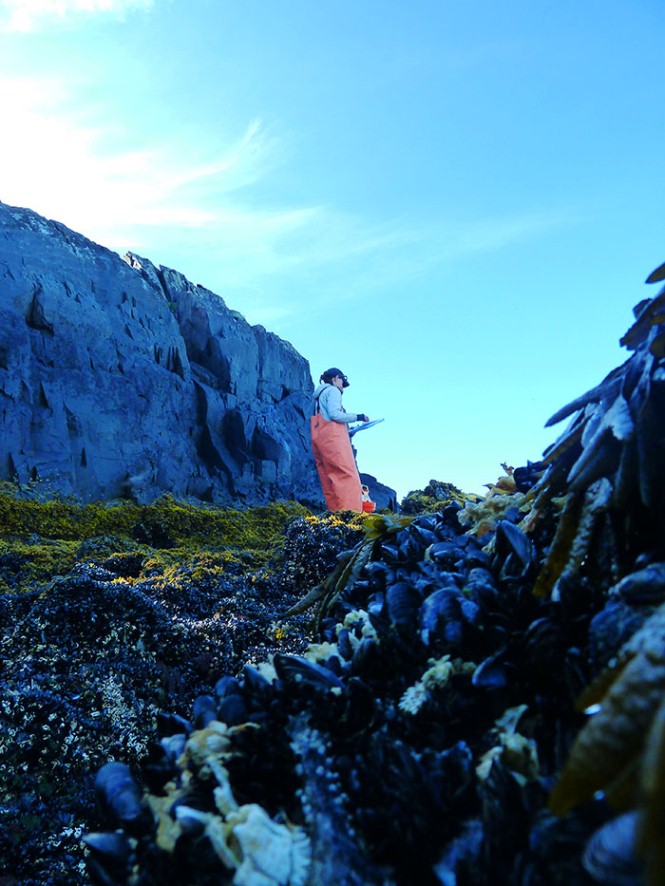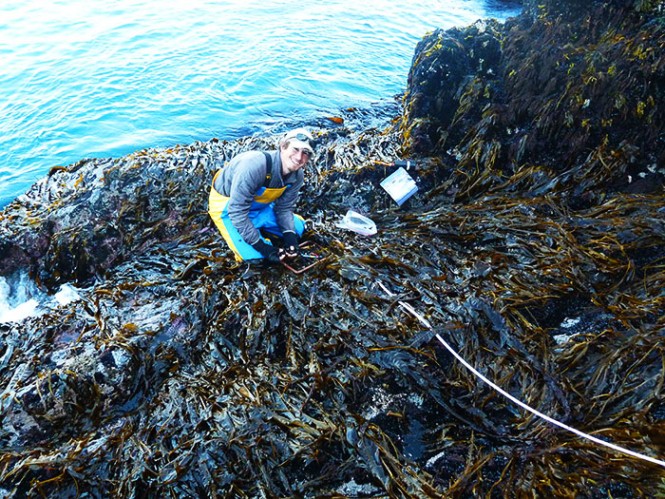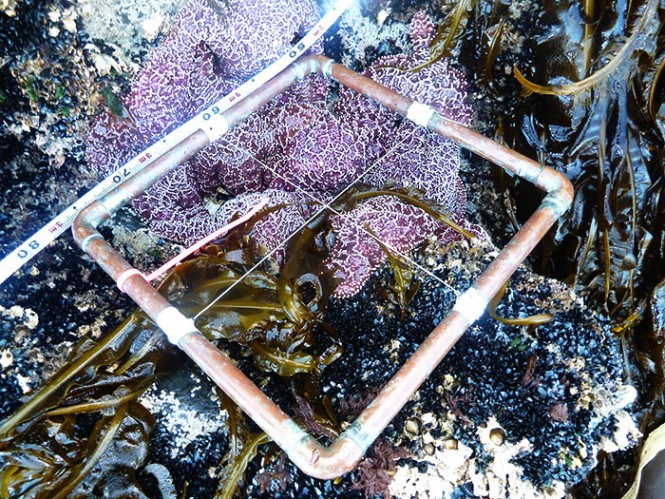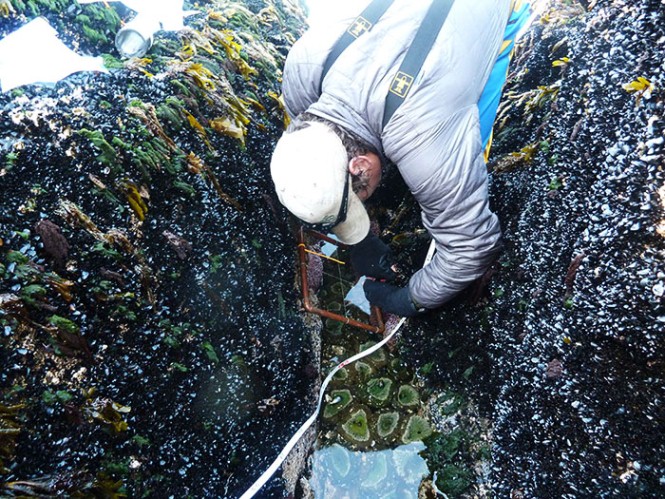![]()

Laura Phillips, the park ecologist, checks the data in the midst of mussels.
Photo: NPS / B. Weitzman
I took my coffee out onto the deck of the USGS R/V Alaskan Gyre to appreciate the blue skies and early morning sunshine in Quartz Bay. After days of rain and waking up before 5am to be in the intertidal in time for sampling the low tide, I appreciated sleeping in until 6am and sipping my coffee while watching sea otters forage on mussels off the starboard beam. Ben, a USGS cooperator, and I would be sampling our long-term monitoring site for blue mussels (Mytilus trossulus) on Beautiful Island this morning. I’ve sampled this site every year for the last five years and it’s one of my favorites. As its name implies, the island is beautiful. Actually a grouping of rocky islets covered in stunted spruce and wildflowers, the small islands are home to sea otters and harbor seals in abundance, and if you look closely, you’ll find harlequin ducks in surprisingly large flocks hiding along the rocky shoreline.

Ben is all smiles while sampling mussels on beautiful island.
Photo: NPS / Laura Phillips
Greg, the captain of the Alaskan Gyre, drops us on the site with the ease of someone who has done that sort of thing every day for many years, which he has. This is my third monitoring trip with Ben, so we fall into a fun conversation as we set up the sampling transects. At each of the 5 sampling sites in the park, we string a 50 meter measuring tape horizontally across the top of the mussel bed, run another tape at ten pre-determined lengths to the bottom of the bed and then sample mussels at a random location along our vertical tape. The actual sampling involves measuring the density of large mussels (i.e. otter food) at the site by collecting all the mussels greater than 20 millimeters in length within a quad and the overall density of mussels by counting all the mussels of any size in a core sample. I’ve done this sampling enough that I find it meditative and enjoyable. Scramble down the mussel covered rock to your random spot, place your quad over the bed, and one by one remove mussels that appear to be big enough to warrant collection by prying them off the rock with fingers or a small tool, place them in a bag. Repeat.
Ben and I are making good time, chatting and laughing and scrambling and bagging mussels until transect 7 when the random location my quad falls on is a most unfortunate place on the mussel bed. Poor quad fall…it happens. You would think with all the mussels on this wall, you wouldn’t encounter a spot lacking enough for a quick sample, but I ended up at one of those places. I take another look at my unlucky quad and then call Ben over for advice. He takes one look and laughs. It’s a Pisaster disaster. Below my quad at least two dozen sea stars, Pisaster ochraceus , are clinging to the rock in a tangle of purple arms and tube feet. Ben recommends I try to pull them off to measure the mussels they have not yet managed to eat below them. Yea, right. Thousands of tube feet sucked onto the rock and each other? I don’t think so. So I follow the monitoring protocol and start flipping my quad to sample a larger area with the hope that I’ll find enough large mussels on the edges of the sea star scrum to meet our sampling objectives. This takes a while.

It's a "Pisaster" Disaster! How to sample mussels when your sample location falls on a pile of sea stars?
Photo: NPS / Laura Phillips
In the meantime, Ben has had an ill-fated random quad fall of his own. How do you sample a tide pool? His quad is located at the bottom of a crack in the rock and in about two feet of water. I come over to check out his predicament and have to laugh at the preposterous perch he has to employ to sample his quad. Head hidden in the crevice, all I see when I come over are his legs in bright yellow and blue Helly’s sticking out above the rock and hear his muffled voice complaining about his awkward position.
![]()

Ben finds an uncomfortable perch to reach his sampling quad when it falls on a tide pool at the bottom of a crack in the rock.
Photo: NPS / Laura Phillips
Eventually we prevail, complete our sampling, take site photos, and take a moment to enjoy sitting in a mussel bed on surrounded by the blue waters and green mountains of the fjords. The data we collected today will contribute to the understanding of the role mussels play in the food web of the marine nearshore environment and how changes in density and size of mussels may influence and be influenced by keystone predators such as sea otters and black oystercatchers. Next year we’ll add another data point, and the year after, and so on, until we can tell the story of this mussel bed through time on a beautiful island in the Gulf of Alaska.
